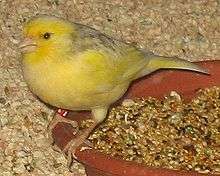Afterdamp
Afterdamp is the toxic mixture of gases left in a mine following an explosion caused by firedamp, which itself can initiate a much larger explosion of coal dust.[1] It consists of carbon dioxide, carbon monoxide and nitrogen. Hydrogen sulfide, another highly toxic gas, may also be present. However, it is the high content of carbon monoxide which kills by depriving victims of oxygen by combining preferentially with haemoglobin in the blood.
Afterdamp was the deadly gas which caused the majority of casualties in the many pit disasters of the British coalfields, such as the Senghenydd colliery disaster and elsewhere in the world. Such disasters continue to afflict working mines, especially in mainland China.
Detection

Animal sentinels, such as mice or canaries, are more sensitive to the gas than humans, so will give a warning to miners. Canaries were introduced into British collieries in the 1890s by John Scott Haldane, the noted physiologist. Gas detectors are available now which detect toxic gases such as carbon monoxide at very low levels. They are widely available to protect domestic premises. The levels of gas detection depend on the methods used.
See also
References
- "After-damp". A Glossary of Mining and Metallurgical Terms. Easton, Pennsylvania: American Institute of Mining Engineers. 1881.
- J S Haldane and J G Priestley, Respiration, Oxford University Press, 2nd ed. (1935)